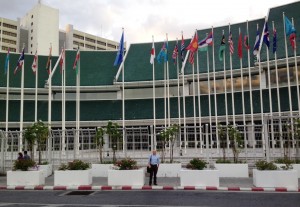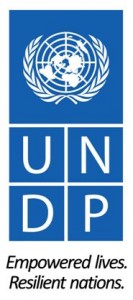
From my workstation in a fourth-floor office of the United Nations Economic and Social Commission for Asia and the Pacific, a 50-foot-long bank of windows offers sweeping views of the Old Bangkok district: Alongside oil-slicked canals and rain-stained shop houses, modern Buddhist temples adorned with glass-mosaic facades and horn-like golden chofa glimmer in the intense Thailand sun. From this vantage, I find it easy to believe that New York is a world away.
I began my internship with the United Nations Development Programme (UNDP) in the Bangkok Regional Hub at the beginning of June, my mind spinning from Bard CEP’s challenging first-year coursework. But with the voices of my professors still ringing in my ears about environmental econometrics, international climate regimes and the importance of planting cover crops, I felt energized to apply all I had learned in my new role.
Although located in the Bangkok Regional Hub, UNDP’s work in the Asia-Pacific region covers 36 nations and territories — from the world’s most populous country to its smallest island state. Three-quarters of the world’s population lives in this region, with cultures, customs and cuisines nearly as varied as its over 4 billion residents. However, countries as seemingly different as Pakistan, Malaysia and Kiribati share at least one important challenge: They all must find a way to adapt to climate change.
Climate Change Adaptation at UNDP
My internship is with the Climate Change Adaptation team, an impressive, international cohort of climate change and development experts who work long hours striving to prepare countries for a warmer world. Unlike projects that support climate change mitigation— which aims to reverse climate change in the long-term by lowering greenhouse gas emissions —climate change adaptation projects seek to reduce communities’ vulnerability to climate impacts now and in the near future.
The UNDP team recognizes that climate change is not a distant problem for their project countries; it is instead already affecting millions of people. Salty water from rising seas intrudes into drinking water supplies in Bangladesh. Erratic rainfall patterns cause rice yields to drop in food-scarce Lao People’s Democratic Republic. Warmer oceans threaten fisheries in Vanuatu.
Unfortunately, the poor are the hardest hit by climate change and are the first to feel its impacts despite being the least responsible for its causes. For this reason, climate change threatens to reverse decades of progress in global development work. But the United Nations is at the forefront of making apparent the connections between poverty, development and environmental sustainability.
What this sometimes dreary news offers me is an opportunity to help countries adapt to climate change, if only for a short six months, through my UNDP internship. During the course of a typical day, I am able to explore a large swath of Asia, virtually, through pages of climate impact reports, smart project proposals, moving UN photography and cutting-edge development publications — with the Bangkok city skyline as my backdrop. And the knowledge and skills gained at Bard inform my contribution.
Promoting Climate-Resilient Water Management in Cambodia
To learn more about UNDP’s work promoting climate-resilient communities in Cambodia, watch the 11-minute video above: “Climate change adaptation in Cambodia.”
To begin, I am assisting my supervisor to plan a closing workshop in mid-November for a six-year climate change adaptation project in Cambodia that is coming to an end. Working with the project team based in Cambodia, I learn best practices for rural development and the challenges they faced in reducing the country’s vulnerability to climate change.
Highly influenced by the Asian monsoon, the climate of Cambodia is expected to show more variable rainfall patterns and warmer temperatures in the coming decades. This precipitation variability will make it increasingly difficult for farmers to plan their planting cycles, especially for paddy rice. Rice is the country’s main staple, is highly water-dependent and, because up to 80 percent of Cambodian people are dependent on agriculture to make their living, the crop’s susceptibility to climatic rainfall changes makes the country very vulnerable to climate change.
The project, “Promoting Climate-Resilient Water Management and Agricultural Practices in Rural Cambodia,” aims to lighten communities’ risk by ensuring farmers have access to water for irrigation during drought, the knowledge they need to plan for future climate stress, and crop varieties proven to fare better during variable conditions.
And the project has been very successful. Here are just few of the project benefits:
- 860 households will have directly benefited from improved water facilities, including community ponds, rainwater harvesting system and solar-powered well pumps.
- 3,018 farmers will have received technical training on climate-resilient agriculture techniques, including drought- and flood-resistant rice varieties, to ensure they are better prepared for variable rain patterns.
- Last year, 18,019 households in 80 villages received and used weather information.
- UNDP is teaming with the Department of Agriculture Land Management to conduct soil assessments and a crop suitability analysis in order to diversify farmers’ planting options with crops better suited to future conditions.
Highlighting Project Sustainability
Although UNDP’s role in this project is closing at the end of this year, project gains are on track to continue far into the future. Sustainability is at the core of UNDP’s development goals, and that means ensuring their partner governments are given the tools they need to carry on the work post project. Mainstreaming climate considerations into government policies and boosting the capacity of policymakers to make informed climate considerations are both key components of the Cambodia water-resilience project’s success.
My job is to help make sure these successes are widely celebrated and that the lessons learned translate to inspired action for workshop attendees in November. I will construct some innovative presentation materials, help guide the workshop agenda, and make sure the voices of local farmers and other beneficiaries are highlighted.
And this is but one of the many projects I will assist with in the months to come. Every day at UNDP takes me someplace new and, given the organization’s forward-thinking approach to climate change adaptation and my supervisors’ tireless efforts on behalf of their project countries, I am proud to be part of the journey.
It is the end of the workday and I step just outside the air-conditioned office space onto a tree-filled, fourth-floor atrium. The smells of spiced curries and diesel fumes waft up from the streets below. Monks chant in unison and a middle school band’s percussion section practices, producing a strangely alluring dissonance. The air is hot, my belly wants fragrant jasmine rice and I feel a little bit less “a world away.”


Always keep a live root, Kale!